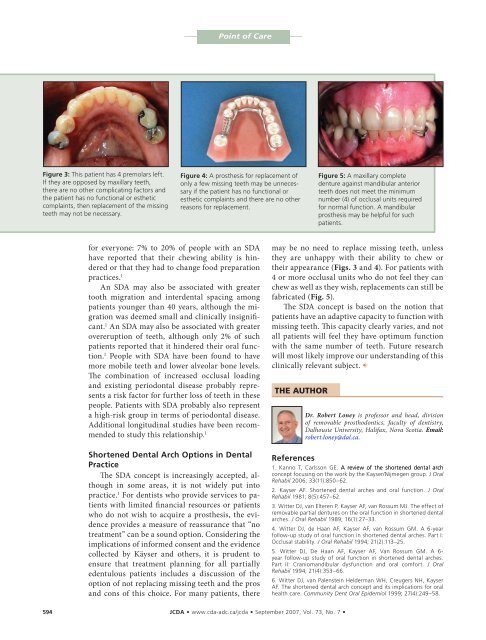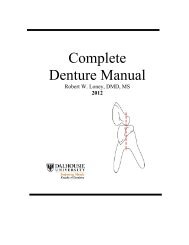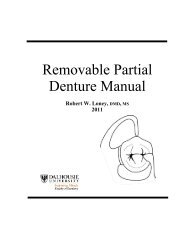Point of Care - Removable Prosthodontics - Dalhousie University
Point of Care - Removable Prosthodontics - Dalhousie University
Point of Care - Removable Prosthodontics - Dalhousie University
Create successful ePaper yourself
Turn your PDF publications into a flip-book with our unique Google optimized e-Paper software.
––––––– <strong>Point</strong> <strong>of</strong> <strong>Care</strong> –––––<br />
Figure 3: This patient has 4 premolars left.<br />
If they are opposed by maxillary teeth,<br />
there are no other complicating factors and<br />
the patient has no functional or esthetic<br />
complaints, then replacement <strong>of</strong> the missing<br />
teeth may not be necessary.<br />
Figure 4: A prosthesis for replacement <strong>of</strong><br />
only a few missing teeth may be unnecessary<br />
if the patient has no functional or<br />
esthetic complaints and there are no other<br />
reasons for replacement.<br />
Figure 5: A maxillary complete<br />
denture against mandibular anterior<br />
teeth does not meet the minimum<br />
number (4) <strong>of</strong> occlusal units required<br />
for normal function. A mandibular<br />
prosthesis may be helpful for such<br />
patients.<br />
for everyone: 7% to 20% <strong>of</strong> people with an SDA<br />
have reported that their chewing ability is hindered<br />
or that they had to change food preparation<br />
practices. 1<br />
An SDA may also be associated with greater<br />
tooth migration and interdental spacing among<br />
patients younger than 40 years, although the migration<br />
was deemed small and clinically insignificant.<br />
1 An SDA may also be associated with greater<br />
overeruption <strong>of</strong> teeth, although only 2% <strong>of</strong> such<br />
patients reported that it hindered their oral function.<br />
1 People with SDA have been found to have<br />
more mobile teeth and lower alveolar bone levels.<br />
The combination <strong>of</strong> increased occlusal loading<br />
and existing periodontal disease probably represents<br />
a risk factor for further loss <strong>of</strong> teeth in these<br />
people. Patients with SDA probably also represent<br />
a high-risk group in terms <strong>of</strong> periodontal disease.<br />
Additional longitudinal studies have been recommended<br />
to study this relationship. 1<br />
Shortened Dental rch Options in Dental<br />
Practice<br />
The SDA concept is increasingly accepted, although<br />
in some areas, it is not widely put into<br />
practice. 1 For dentists who provide services to patients<br />
with limited financial resources or patients<br />
who do not wish to acquire a prosthesis, the evidence<br />
provides a measure <strong>of</strong> reassurance that “no<br />
treatment” can be a sound option. Considering the<br />
implications <strong>of</strong> informed consent and the evidence<br />
collected by Käyser and others, it is prudent to<br />
ensure that treatment planning for all partially<br />
edentulous patients includes a discussion <strong>of</strong> the<br />
option <strong>of</strong> not replacing missing teeth and the pros<br />
and cons <strong>of</strong> this choice. For many patients, there<br />
may be no need to replace missing teeth, unless<br />
they are unhappy with their ability to chew or<br />
their appearance (Figs. 3 and 4). For patients with<br />
4 or more occlusal units who do not feel they can<br />
chew as well as they wish, replacements can still be<br />
fabricated (Fig. 5).<br />
The SDA concept is based on the notion that<br />
patients have an adaptive capacity to function with<br />
missing teeth. This capacity clearly varies, and not<br />
all patients will feel they have optimum function<br />
with the same number <strong>of</strong> teeth. Future research<br />
will most likely improve our understanding <strong>of</strong> this<br />
clinically relevant subject. a<br />
THE AUTHOR<br />
References<br />
Dr. Robert Loney is pr<strong>of</strong>essor and head, division<br />
<strong>of</strong> removable prosthodontics, faculty <strong>of</strong> dentistry,<br />
<strong>Dalhousie</strong> <strong>University</strong>, Halifax, Nova Scotia. Email:<br />
robert.loney@dal.ca.<br />
1. Kanno T, Carlsson GE. A review <strong>of</strong> the shortened dental arch<br />
concept focusing on the work by the Kayser/Nijmegen group. J Oral<br />
Rehabil 2006; 33(11):850–62.<br />
2. Kayser AF. Shortened dental arches and oral function. J Oral<br />
Rehabil 1981; 8(5):457–62.<br />
3. Witter DJ, van Elteren P, Kayser AF, van Rossum MJ. The effect <strong>of</strong><br />
removable partial dentures on the oral function in shortened dental<br />
arches. J Oral Rehabil 1989; 16(1):27–33.<br />
4. Witter DJ, de Haan AF, Kayser AF, van Rossum GM. A 6-year<br />
follow-up study <strong>of</strong> oral function in shortened dental arches. Part I:<br />
Occlusal stability. J Oral Rehabil 1994; 21(2):113–25.<br />
5. Witter DJ, De Haan AF, Kayser AF, Van Rossum GM. A 6-<br />
year follow-up study <strong>of</strong> oral function in shortened dental arches.<br />
Part II: Craniomandibular dysfunction and oral comfort. J Oral<br />
Rehabil 1994; 21(4):353–66.<br />
6. Witter DJ, van Palenstein Helderman WH, Creugers NH, Kayser<br />
AF. The shortened dental arch concept and its implications for oral<br />
health care. Community Dent Oral Epidemiol 1999; 27(4):249–58.<br />
594 www.cda-adc.ca/jcda • September 2007, Vol. 73, No. 7 •















